NCERT Solutions for Exercise 12.2 Class 9 Maths Chapter 12 - Heron's Formula
NCERT Solutions for Class 9 Maths Chapter 12: Heron's Formula Exercise 12.2- Download Free PDF
NCERT Solutions for Class 9 Maths Chapter 12: Heron’s Formula Exercise 12.2- In 9th class maths exercise 12.2 answers, you're about to become a geometry magician. Heron's Formula is your secret spell for finding triangle areas when you know the sides. class 9 maths chapter 12 exercise 12.2 is your practical practice field. It's all about solving different triangle puzzles using Heron's Formula.
And here's the best part: You can download these exercise 12.2 class 9 maths for free in PDF. That means you can work on your magic offline, anytime you want, with these helpful guides. Let's dive into the world of triangles and Heron's Formula with confidence!
NCERT Solutions for Class 9 Maths chapter 12 exercise 12.2 is about the application of heron’s formula in finding areas of quadrilaterals. In order to solve NCERT book question for Class 9 Maths exercise 12.2, we will require information such as perimeters and areas of several of these shapes, such as rectangles and squares along with this basic area of the triangle. Heron's formula may also be used to compute the area of a quadrilateral if the quadrilaterals are divided into triangular sections. Once the quadrilaterals have been divided into triangular forms, use Heron's formula to calculate the area of individual triangular parts. Add the areas of each triangle section to get the quadrilateral's area once you've computed their areas. The following activities are included with Class 10 Mathematics chapter 12 exercise 12.2.
**As per the CBSE Syllabus for 2023-24, please note that this chapter has been renumbered as Chapter 10. So, when referring to this chapter, consider it as Chapter 10 - Heron's Formula.
Download PDF of NCERT Solutions for Class 9 Maths Chapter 12 – Heron’s Formula Exercise 12.2
Access Heron's Formula Class 9 Chapter 12 Exercise: 12.2
Answer:
From the figure:
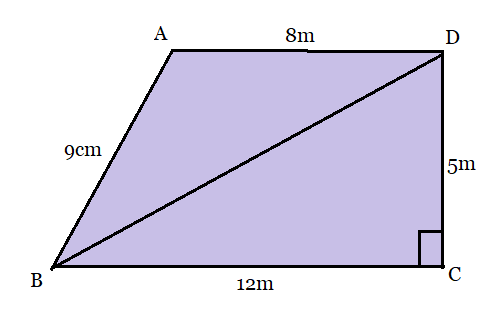
We have joined the BD to form two triangles so that the calculation of the area will be easy.
In triangle BCD, by Pythagoras theorem
$BD^2 = BC^2+CD^2$
$\Rightarrow BD^2 = 12^2+5^2 = 144+25 = 169$
$\Rightarrow BD = 13\ cm$
The area of triangle BCD can be calculated by,
$Area_{(BCD)} = \frac{1}{2}\times BC\times DC = \frac{1}{2}\times 12\times 5 = 30\ cm^2$
and the area of the triangle DAB can be calculated by Heron's Formula:
So, the semi-perimeter of the triangle DAB,
$s = \frac{a+b+c}{2} = \frac{9+8+13}{2} = \frac{30}{2} = 15\ cm$
Therefore, the area will be:
$A = \sqrt{s(s-a)(s-b)(s-c)}$
where, $a = 9 cm,\ b = 8cm\ and\ c = 13cm$ .
$= \sqrt{15(15-9)(15-8)(15-13)}$
$= \sqrt{12(6)(7)(2)} = \sqrt{1260} = 35.5\ cm^2$ (Approximately)
Then, the total park area will be:
$= Area\ of\ triangle\ BCD + Area\ of\ triangle\ DAB$
$\Rightarrow$ $Total\ area\ of\ Park = 30+35.35 = 65.5\ cm^2$
Hence, the total area of the park is $65.5\ cm^2.$
Answer:
From the figure:
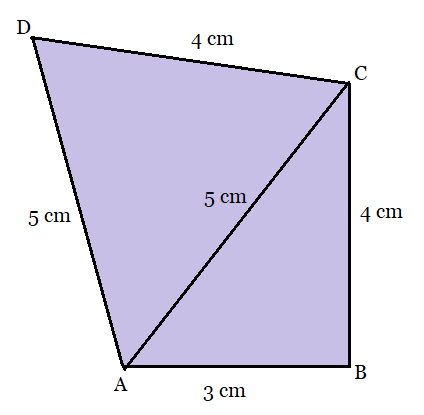
We have joined the AC to form two triangles so that the calculation of the area will be easy.
The area of the triangle ABC can be calculated by Heron's formula:
So, the semi-perimeter, where $a = 3 cm,\ b =4cm\ and\ c = 5cm.$
$s = \frac{a+b+c}{2} = \frac{3+4+5}{2} = 6cm$
Heron's Formula for calculating the area:
$A = \sqrt{s(s-a)(s-b)(s-c)}$
$= \sqrt{6(6-3)(6-4)(6-5)}= \sqrt{6(3)(2)(1)} = \sqrt{36} = 6\ cm^2$
And the sides of the triangle ACD are $a' =4cm,\ b' = 5cm\ and\ c' = 5cm.$
So, the semi-perimeter of the triangle:
$s' = \frac{a'+b'+c'}{2} = \frac{4+5+5}{2} = \frac{14}{2} = 7cm$
Therefore, the area will be given by, Heron's formula
$A = \sqrt{s'(s'-a')(s'-b')(s'-c')}$ .
$= \sqrt{7(7-4)(7-5)(7-5)}$
$= \sqrt{7(3)(2)(2)} = 2\sqrt{21} = 9.2\ cm^2\ \ \ \ (Approx.)$
Then, the total area of the quadrilateral will be:
$= Area\ of\ triangle\ ABC + Area\ of\ triangle\ ACD$
$\Rightarrow$ $Total\ area\ of\ quadrilateral\ ABCD = 6+9.2 = 15.2\ cm^2$
Hence, the area of the quadrilateral ABCD is $15.2 \ cm^2.$
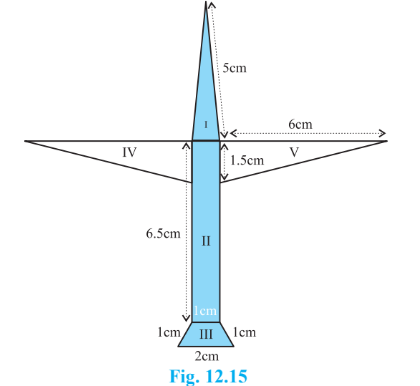 Answer:
Answer:
The total area of the paper used will be the sum of the area of the sections I, II, III, IV, and V. i.e., $Total\ area = I +II+III+IV+V$
For section I:
Here, the sides are $a = 1cm\ and\ b =c = 5cm.$
So, the Semi-perimeter will be:
$s = \frac{a+b+c}{2} = \frac{5+5+1}{2} = 5.5\ cm$
Therefore, the area of section I will be given by Heron's Formula,
$A = \sqrt{s(s-a)(s-b)(s-c)}$
$= \sqrt{5.5(5.5-1)(5.5-5)(5.5-5)}$
$= \sqrt{5.5(4.5)(0.5)(0.5)} = \sqrt{6.1875} = 2.5\ cm^2\ \ \ \ \ \ (Approx.)$
For section II:
Here the sides of the rectangle are $l =6.5\ cm$ and $b =1 \ cm.$
Therefore, the area of the rectangle is $= l\times b = 6.5\times 1 = 6.5\ cm^2.$
For section III:
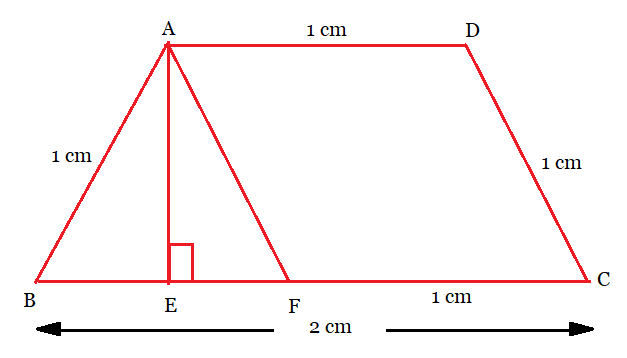
From the figure:
Drawing the parallel line AF to DC and a perpendicular line AE to BC.
We have the quadrilateral ADCF,
$AF || DC$ ...........................by construction.
$AD || FC$ ...........................[ $\because$ ABCD is a trapezium]
So, ADCF is a parallelogram.
Therefore, $AF = DC = 1\ cm$ and $AD = FC = 1\ cm$
$\left [ \because Opposite\ sides\ of\ a\ parallelogram \right ]$
Therefore, $BF = BC -FC =2-1 = 1\ cm.$
$\implies$ ABF is an equilateral triangle. $\left [ \because AB = BF =AF = 1\ cm \right ]$
Then, the area of the equilateral triangle ABF is given by:
$\implies \frac{\sqrt3}{4}a^2 = \frac{\sqrt3}{4}1^2 = \frac{\sqrt3}{4}$
$= \frac{1}{2}\times BF \times AE$
$= \frac{1}{2}\times 1cm \times AE = \frac{\sqrt3}{4}$
$\implies AE = \frac{\sqrt3}{2} = \frac{1.732}{2} = 0.866 \approx 0.9$
Hence, the area of trapezium ABCD will be:
$= \frac{1}{2}\times(AD+BC)\times AE$
$= \frac{1}{2}\times(1+2)\times 0.9$
$=1.35 =1.4\ cm^2\ \ \ \ (Approx.)$
For Section IV:
Here, the base is 1.5 cm and the height is 6 cm.
Therefore, the area of the triangle is :
$= \frac{1}{2}\times base\times height$
$= \frac{1}{2}\times 1.5\times 6 = 4.5\ cm^2$
For section V:
The base length = 1.5cm and the height is 6cm.
Therefore, the area of the triangle will be:
$= \frac{1}{2}\times 1.5\times 6 = 4.5\ cm^2$
Hence, the total area of the paper used will be:
$Total\ area = I +II+III+IV+V$
$= 2.5+6.5+1.4+4.5+4.5 = 19.4\ cm^2$
Answer:
From the figure:
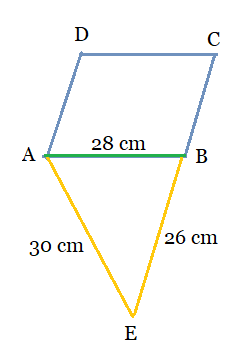 The sides of the triangle are $a = 26\ cm,b= 28\ cm\ and\ c =30\ cm.$
The sides of the triangle are $a = 26\ cm,b= 28\ cm\ and\ c =30\ cm.$
Then, calculating the area of the triangle:
So, the semi-perimeter of triangle ABE,
$s = \frac{a+b+c}{2} = \frac{28+26+30}{2} = 42\ cm.$
Therefore, its area will be given by the Heron's formula:
$A = \sqrt{s(s-a)(s-b)(s-c)}$
$= \sqrt{42(42-28)(42-26)(42-30)}$
$= \sqrt{42(14)(16)(12)} = \sqrt{112896} = 336\ cm^2$
Given that the area of the parallelogram is equal to the area of the triangle:
$Area\ of\ Parallelogram = Area\ of\ Triangle$
$\implies base\times corresponding\ height = 336\ cm^2$
$\implies 28\times corresponding\ height = 336\ cm^2$
$\implies height = \frac{336}{28} = 12\ cm.$
Hence, the height of the parallelogram is 12 cm.
Answer:
To find the area of the rhombus:
We first join the diagonal AC of quadrilateral ABCD. (See figure)
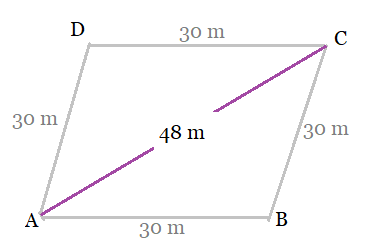 Here, the sides of triangle ABC are,
Here, the sides of triangle ABC are,
$a = 30\ m,\ b = 30\ m\ and\ c = 48\ m.$
So, the semi-perimeter of the triangle will be:
$s = \frac{a+b+c}{2} = \frac{30+30+48}{2} = \frac{108}{2} = 54\ m$
Therefore, the area of the triangle given by the Heron's formula,
$Area = \sqrt{s(s-a)(s-b)(s-c)}$
$= \sqrt{54(54-30)(54-30)(54-48)}$
$= \sqrt{54(24)(24)(6)} = \sqrt{186624} = 432\ m^2$
Hence, the area of the quadrilateral will be:
$= 2\times 432\ m^2 = 864\ m^2$
Therefore, the area grazed by each cow will be given by,
$= \frac{Total\ area}{Number\ of\ cows} = \frac{864}{18} = 48\ m^2.$
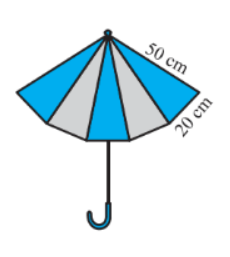 Answer:
Answer:
The sides of the triangle are:
$a = 20\ cm,\ b = 50\ cm\ and\ c =50\ cm.$
So, the semi-perimeter of the triangle is given by,
$s = \frac{a+b+c}{2} = \frac{20+50+50}{2} = \frac{120}{2} = 60\ cm.$
Therefore, the area of the triangle can be found by using Heron's formula:
$Area = \sqrt{s(s-a)(s-b)(s-c)}$
$= \sqrt{60(60-20)(60-50)(60-50)}$
$= \sqrt{60(40)(10)(10)} = 200\sqrt{6}\ cm^2$
Now, for the 10 triangular pieces of cloths, the area will be,
$= 10\times200\sqrt6 = 2000\sqrt6\ cm^2$
Hence, the area of cloths of each colour will be:
$= \frac{2000\sqrt6}{2} = 1000\sqrt6\ cm^2.$
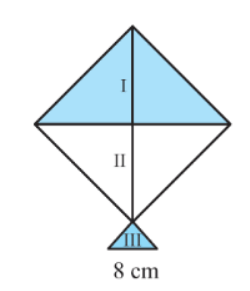 Answer:
Answer:
From the figure:
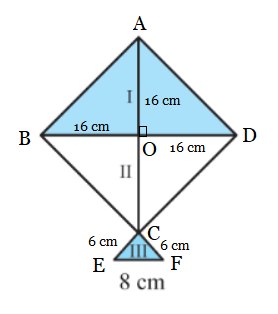 Calculation of the area for each shade:
Calculation of the area for each shade:
The shade I: Triangle ABD
Here, base $BD = 32\ cm$ and the height $AO = 16\ cm.$
Therefore, the area of triangle ABD will be:
$= \frac{1}{2} \times base\times height = \frac{1}{2}\times 32\times 16$
$= 256\ cm^2$
Hence, the area of paper used in shade I is $256\ cm^2.$
Shade II: Triangle CBD
Here, base $BD = 32\ cm$ and height $CO = 16\ cm.$
Therefore, the area of triangle CBD will be:
$= \frac{1}{2} \times base\times height = \frac{1}{2}\times 32\times 16$
$= 256\ cm^2$
Hence, the area of paper used in shade II is $256\ cm^2.$
Shade III: Triangle CEF
Here, the sides are of lengths, $a = 6\ cm,\ b = 6\ cm\ and\ c = 8\ cm.$
So, the semi-perimeter of the triangle:
$s = \frac{a+b+c}{2} = \frac{6+6+8}{2} = \frac{20}{2} = 10\ cm.$
Therefore, the area of the triangle can be found by using Heron's formula:
$Area = \sqrt{s(s-a)(s-b)(s-c)}$
$= \sqrt{10(10-6)(10-6)(10-8)}$
$= \sqrt{10(4)(6)(2)}$
$= 8\sqrt{5}\ cm^2$
Hence, the area of the paper used in shade III is $8\sqrt{5}\ cm^2$ .
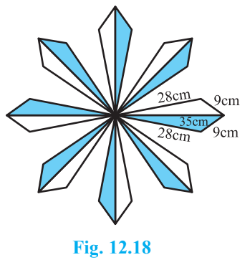 Answer:
Answer:
GIven the sides of the triangle are:
$a = 9\ cm,\ b = 28\ cm\ and\ c= 35\ cm.$
So, its semi-perimeter will be:
$s = \frac{a+b+c}{2} = \frac{9+28+35}{2} = 36\ cm$
Therefore, the area of the triangle using Heron's formula is given by,
$Area = \sqrt{s(s-a)(s-b)(s-c)}$
$= \sqrt{36(36-9)(36-28)(36-35)} = \sqrt{36(27)(8)(1)}$
$= \sqrt{7776} \approx 88.2\ cm^2$
So, we have the area of each triangle tile which is $88.2\ cm^2$ .
Therefore, the area of each triangular 16 tiles will be:
$= 16\times 88.2\ cm^2 = 1411.2\ cm^2$
Hence, the cost of polishing the tiles at the rate of 50 paise per cm 2 will be:
$= Rs.\ 0.50\times1411.2\ cm^2 =Rs.\ 705.60$
Answer:
The trapezium field is shown below in figure:
Drawing line CF parallel to AD and a line perpendicular to AB, we obtain
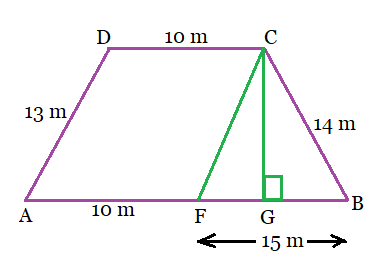 Then in quadrilateral ADCF,
Then in quadrilateral ADCF,
$CF || AD$ ............................ $\left [ \because\ by\ construction \right ]$
$CD || AF$ ............................ $\left [ \because ABCD\ is\ a\ trapezium \right ]$
Therefore, ADCF is a parallelogram.
So, $AD = CF = 13\ m$ and $CD = AF = 10\ m$
$\left ( \because Opposite\ sides\ of\ a\ parallelogram \right )$
Therefore, $BF = AB-AF = 25-10 = 15\ m$
Now, the sides of the triangle;
$a = 13\ m,\ b =14\ m\ and\ c = 15\ m.$
So, the semi-perimeter of the triangle will be:
$s= \frac{a+b+c}{2} = \frac{13+14+15}{2} = \frac{42}{2} = 21\ m$
Therefore, the area of the triangle can be found by using Heron's Formula:
$Area = \sqrt{s(s-a)(s-b)(s-c)}$
$= \sqrt{21(21-13)(21-14)(21-15)}$
$= \sqrt{21(8)(7)(6)}$
$= \sqrt{7056} = 84\ m^2.$
Also, the area of the triangle is given by,
$Area = \frac{1}{2}\times BF\times CG$
$\Rightarrow \frac{1}{2}\times BF\times CG = 84\ m^2$
$\Rightarrow \frac{1}{2}\times 15\times CG = 84\ m^2$
Or,
$\Rightarrow CG = \frac{84\times2}{15} = 11.2\ m$
Therefore, the area of the trapezium ABCD is:
$= \frac{1}{2} \times (AB+CD)\times CG$
$= \frac{1}{2} \times (25+10)\times 11.2$
$= 35\times5.6$
$= 196\ m^2$
Hence, the area of the trapezium field is $196\ m^2.$
More Information About NCERT Solutions for Class 9 Maths Exercise 12.2
In solving the NCERT solutions for Class 9 Maths exercise 12.2 we not only need the knowledge about how to apply the heron formula, how to find a semi perimeter but we also need the information about properties of quadrilaterals that will be helpful in solving the questions. The heron formula is not used to find the area of regular shapes like trapezium, parallelogram but we can also use the heron formula to determine the area of any irregular quadrilateral by converting the quadrilateral into triangles.
Also Read| Heron's Formula Class 9 Notes
Benefits of NCERT Solutions for Class 9 Maths Exercise 12.2
NCERT syllabus Class 9 Maths chapter 12 exercise 12.2 broadly covers the knowledge application of heron’s formula in finding areas of quadrilaterals
Class 9 Maths chapter 12 exercise 12.2 is best to clear base as it covers all kinds of questions that can be formed on the application of heron’s formula in finding areas of quadrilaterals
Heron formula is very useful in quadrilateral as we don't need any height and angle we just need the length of sides to solve for the area
Heron formula can be used in entrance exams like JEE Main and to solve the question-related area of a triangle as heron formula is easier than other formulas when sides are given
Key Features of Class 9 Maths Chapter 12 Exercise 12.2
Advanced Exploration of Heron's Formula: Exercise 12.2 class 9 maths builds upon the concepts introduced in Exercise 12.1, allowing students to further apply Heron's Formula to calculate the areas of triangles with given side lengths.
Step-by-Step Solutions: The 9th class maths exercise 12.2 answers provide detailed, step-by-step explanations for each problem, guiding students through complex triangle area calculations.
Practical Applications: This ex 12.2 class 9 challenges students with a variety of problems that require the application of Heron's Formula, enhancing their problem-solving skills in geometry.
Clear and Understandable Language: Solutions are presented in clear and understandable language to ensure students can grasp the concepts with ease.
PDF Format: Students can access the class 9 ex 12.2 solutions in PDF format for free download, allowing offline use and convenient learning.
Also, see-
NCERT Solutions of Class 10 Subject Wise
Subject Wise NCERT Exemplar Solutions
Frequently Asked Questions (FAQs)
There can be many alternative methods of solving the problem as we can break quadrilaterals into different types of triangles.
Information such as the opposite side of a parallelogram are equal or one of the opposite sides of trapezium equal are parallel
We can divide trapezium into two right-angle triangles and a rectangle
The most common way of dividing parallelogram and rhombus in a triangle to apply the heron formula is by diagonal
Floor designs, umbrella and Paper planes are some of the real-life applications which we have used in Class 9 Maths chapter 12 exercise 12.2
Exercise 12.2 in Class 9 Maths presents a variety of fundamental problems in which we must apply the Heron formula to a quadrilateral and provide real-life examples to make the questions more interesting to solve.
There are three solved examples that were addressed before Class 9 Maths chapter 12 exercise 12.2
The total number of questions answered in Class 9 Maths chapter 12 exercise 12.2 are 9
Courses After 12th
Applications for Admissions are open.
As per latest syllabus. Physics formulas, equations, & laws of class 11 & 12th chapters
JEE Main Important Chemistry formulas
Get nowAs per latest syllabus. Chemistry formulas, equations, & laws of class 11 & 12th chapters
JEE Main high scoring chapters and topics
Get nowAs per latest 2024 syllabus. Study 40% syllabus and score upto 100% marks in JEE
JEE Main Important Mathematics Formulas
Get nowAs per latest syllabus. Maths formulas, equations, & theorems of class 11 & 12th chapters
